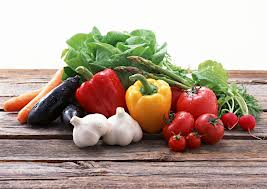
Original Article By Ed Bauman, M.Ed., Ph.D.
Establishing a diet direction is a way to organize the amounts and varieties of foods one chooses to consume in order to...
 Original Article By Ed Bauman, M.Ed., Ph.D.
Original Article By Ed Bauman, M.Ed., Ph.D.A Balancing Diet is comprised of a higher proportion of carbohydrate foods and less fat than is found in the Building direction, though there is some overlap between the two. A prudent application of the USDA MyPlate is an example of this direction.
A Balancing diet would include a wide variety of healthful foods and would typically supply 20% of calories from protein, 30% of calories from fat, and 50% of calories from carbohydrates. It can be a long-term, healthful direction for those with undamaged metabolisms, and is often a good option as the weather warms, as it emphasizes increased amounts of cooling vegetables and fruits. The key to this approach is that the foods be seasonal, local, and organic whenever possible. The Balancing diet in the Eating for Health approach is quite different than the so-called “balanced diet” advised by industry-driven nutritionists and dieticians.
Many people today are confused about carbohydrates, thinking they are all bad. In fact, unrefined starchy carbohydrates are an essential part of the diet. It is refined carbohydrates in the form of flour and sugar that wreak havoc on one’s health. The healthpromoting unrefined carbohydrates include grains, vegetables, and fruits.
Eating for Health suggests using whole, non-gluten grains, such as rice, millet, and quinoa, as staple grains (in lieu of the traditionally overly consumed and more allergenic wheat, corn, oats, and rye) and soaking or fermenting them for optimal nutrient availability. Roughly equal amounts of fruits and vegetables may be consumed, with an emphasis on eating whole fruits rather than juice or fruit products made from concentrates, to moderate the amount of sugar the body will have to metabolize at one sitting. Small amounts of raw fermented foods are also recommended for all dietdirections to supply beneficial bacteria, enzymes, and enhanced nutrient content.
More carbohydrate confusion ensues due to both starchy and non-starchy being lumped under one umbrella term. It is true that some people maintain better health if they limit their grain intake. However, they should still be consuming starchy carbohydrates in the form of tubers, winter squashes, and root vegetables. Non-starchy vegetables (leafy greens, broccoli, celery, etc.) should not be limited and do not count when reducing carbohydrate intake.

A Cleansing Diet will consist of significantly more calories from carbohydrates (>60%) relative to proteins (≤20%) and fats (≤20%). This is a fat-sparing, adequate-protein, highunrefined carbohydrate, low-glycemic (sugarcontent) diet. The Ornish, Weil, McDougall, and hypoallergenic diets are all in this category.
The main objective is to lower the fat content while maintaining adequate protein and increasing the amount of fruits and vegetables in the diet. Dairy products, eggs, wheat, soy, citrus, peanuts, and tree nuts would also be eliminated due to their being possible allergenic foods. Proteins from vegetable sources such as beans and legumes, seeds and nuts, and marine algae would be preferred over meat, fish, or fowl, though broths made from the bones of
pastured animals can be very supportive of the cleansing process.
Maintaining an alkaline-forming diet by including generous amounts of fresh fruits and vegetables, as well as their juices, fermented vegetables, and chlorophyll-rich foods like herbs and micro-greens powders, would replenish the micronutrients that are commonly missing from a non-plant-based diet.

Establishing a diet direction is a way to organize the amounts and varieties of foods one chooses to consume in order to...

The key to successfully applying a diet direction is to build the food plan on top...